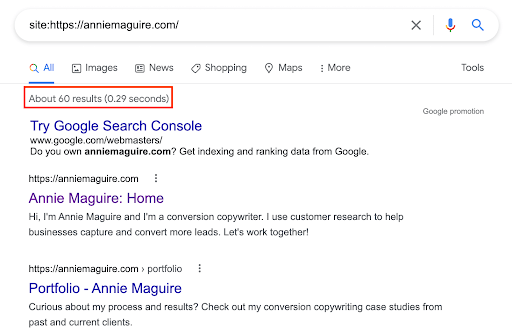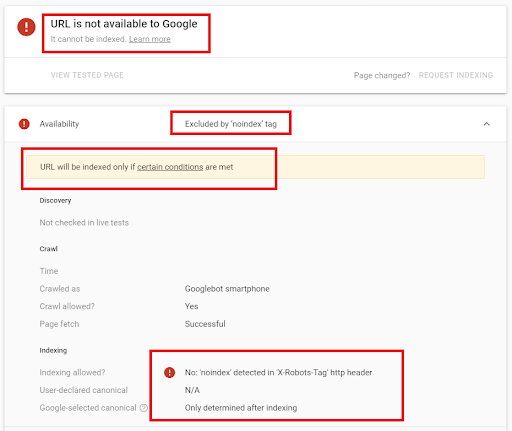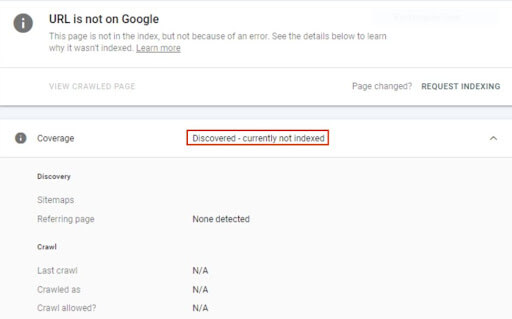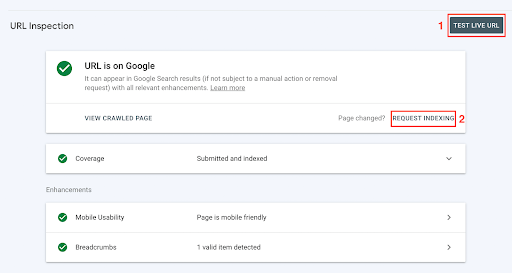Guest post alert! This article was written by Victoria Kurichenko. She is the founder of Self Made Millennials, a self-made marketer and content writer who helps her clients and other solopreneurs master the art and science of SEO writing. Take it away, Victoria!
A decade ago, a simple web page stuffed with keywords could rank number one on Google. But today, that’s no longer the case.
According to Backlinko, there are over 200 Google search algorithms to assess the quality and relevance of web pages, yet no one really knows Google’s search algorithm or ranking system; they keep it a secret.
However, curious webmasters have figured out a few tips for how to get your website noticed on search engines, which is exactly what we’ll be focused on today.
In the following article, I will use my experience as a marketer, content writer, and owner of a high-ranking website to share answers to the following popular questions:
- How to get your website noticed in 2022?
- How to make your website visible on Google search?
- Three reasons why your website is not showing up on Google
- How to make your website show up on Google?
But before we get into the details, let’s cover some of the basics, including the three-step process for how search engines discover web pages.
What are the most common ways a search engine discovers a web page?
According to Google Search Central, Google follows this three-step process to discover new web pages:
- Crawling
- Indexing
- Ranking
Let’s start with the first item on the list: Crawling.
Crawling can be compared to simple reading. Like other search engines, Google has a web crawler, called the Google bot, that browses the Internet and crawls website pages.
According to Siteefy, over 250,000 new web pages are created daily, which means the Google bot is constantly “reading” content.
If you’re publishing new content on your site, you may be wondering how you can get those pages noticed.
The new pages are discovered when website owners submit a list of pages as a “sitemap” via Google Search Console.
You can quickly check if your website has a sitemap by adding a /sitemap.xml to the domain name, like this: https://anniemaguire.com/sitemap.xml. A quick sitemap test will also help you check if your website has a sitemap.

The next way Google discovers new web pages is through Indexing.
If crawling can be compared to simple reading, indexing can be compared to understanding and analyzing the information by the Google bot.
Once a new page is discovered, the Google bot tries to understand the purpose of the page, as well as when it should be shown, and for which keywords.
In order to know when to display a page, Google pulls from a huge database called the Google index where it stores all the crawled and indexed pages.
If you are a website owner, you can check your indexability status through your Google Search Console. In other cases, you can use this search operator to check whether your website is in the Google index:
site:https://anniemaguire.com/

Finally, the third way Google discovers new web pages is through ranking.
Ranking happens every time users search for anything online.
For example, let’s say your page is about “conversion copywriting services.” In the United States, this page may rank on the first page of Google, but in Europe (and in other areas), that may not be the case.
This happens because you, me, and other people across the globe have different likes, tastes, and online behaviors. Therefore, Google customizes the search result page (and the rankings, as a result) to show you the most relevant websites based on your location at a particular moment of time.
Now that you understand the 3 ways Google discovers new web pages, let’s cover the three main reasons your website isn’t showing up on Google.
Why isn’t your website showing up on Google?
As we just covered, all new web pages go through an automated process of discoverability.
However, not every published page becomes searchable, which is why you may still be asking questions like, “ why can’t I find my website on Google?” or “how can I make my website show up on Google?”
If you find yourself asking these questions, you’re not alone. According to an Ahrefs study, more than 90% of all web pages get zero organic traffic.
It can be frustrating to try and get your website noticed on Google only to get a few visitors a month. You may be wondering what the issue is and how you can get found on Google.
Below, I outline the 3 most common website indexing issues I’ve experienced as a marketer, as well as the simple solutions you can use to get your website noticed by Google.
1. No Index Tag
While it’s such a small and simple thing, the “no index tag” could lead to adverse consequences for your website.
If you’re not familiar, a “no index tag” can be used when you have pages on your site that are needed, but you don’t want them to be indexed or ranked (like a “thank you” page, for example).
Here’s what Google says about the index tag:
“You can prevent a page or other resource from appearing in Google Search by including a no index meta tag or header in the HTTP response. When Googlebot next crawls that page and sees the tag or header, Googlebot will drop that page entirely from Google Search results, regardless of whether other sites link to it.”
This means if you have a “no index tag” on your page, Google will completely ignore it; it won’t be searchable and no one will access it from Google.
To find out if you have a “no index tag” on your site, do a quick website audit to identify the affected pages and remove the tag.
You can do this manually by using the Ctrl+F or Command+F. If you can spot the following piece of code, then your page is excluded from the index:
<meta name=”robots” content=”noindex, follow”>
![]()
This method works well for small websites, but what if you have a website with over a hundred pages? Checking every page manually will take a lot of your time. Luckily, there are tools and strategies to simplify this process.
SEO tools like Ahrefs and Semrush run site audits that can help you quickly discover unindexed pages in seconds.
If you are a website owner with a verified Google Search Console account, then you’ll get notifications whenever an indexability issue is discovered (if you don’t have a Google Search Console account, I recommend creating one).

2. Robots.txt
If a “no index tag” messes up one page at a time, issues with “robots.txt” can prevent your entire site from indexing. How is this possible? And if this is happening to you, what can you do to get your website noticed on the Internet?
Robots.txt is a file that tells the Google bot which website pages are allowed for indexing. Google claims robots.txt is not designed to remove your website from the main index, but is recommended as a way to avoid overloading your site with requests.
You can check if your website has a robots.txt file by adding a /robots.txt to your domain name, like this https://anniemaguire.com/robots.txt.
Here is what a simple robots.txt file should look like to allow the entire website indexing:
User-agent: *
Allow: /
The following rules in the robots.txt file will tell Google to disallow the crawling of the entire website. You don’t want it to happen if your website is live. Therefore, have a look at your website’s robots.txt file to ensure it’s up and running.
User-agent: *
Disallow: /
If you see a 404 page instead of the robots.txt file, it means your website does not have it. It’s not necessarily a bad sign. Even though Google says it’s not mandatory, I recommend you add the robots.txt file to your website’s root folder (if you’re not sure how to do that, Google has a simple guide on creating and submitting a robots.txt file).
3. Crawled/Discovered — Not Indexed
Crawled/discovered — not indexed is one of the most annoying mistakes that can stop your website from being seen by Google.
When done correctly, you should see a “URL in on Google” notification in Google Search Console. But like many website owners, I occasionally get the following message:

What does this issue have to do with your website? And if you’re experiencing this issue, how can you get your business website noticed?
Let’s see how Google explains it.
“Crawled — currently not indexed: The page was crawled by Google, but not indexed. It may or may not be indexed in the future; no need to resubmit this URL for crawling.
Discovered — currently not indexed: The page was found by Google, but not crawled yet. Typically, Google wanted to crawl the URL, but this was expected to overload the site; therefore Google rescheduled the crawl. This is why the last crawl date is empty on the report.”
In other words, Google might skip indexing new pages if the process can somehow overload your website (the same issues can also occur if your website has usability issues and poor mobile performance – more on that in a moment).
The “discovered — currently not indexed” issue might disappear in 1-2 days if Google crawls your web page again without overloading your server and if no other errors occur. All you have to do is wait and see if the issue resolves itself.
If your website pages are crawled, but excluded from the main Google index, you have to investigate the potential reasons.
Your website might have poor indexability due to the following reasons:
- Poor mobile usability
- Poor content quality (duplicate content, copied from other websites, short content on a page, etc)
- Poor user experience
- Poor loading speed (use Google Page Speed Insights to check your website’s loading speed)
- Slow server response time
- Unoptimized WordPress theme
- Etc
The reasons are endless, but those are the indexability issues I’ve encountered, fixed, and observed for my own website.
If you don’t see the desired “URL on Google” notification in Google Search Console, make sure to test your affected page first, discover and fix the issues, and request indexing again. If no errors occur, Google will add your affected page to the main index.

How to get your website noticed on Google for free
A well-optimized, high-performing website is a dream come true for any website owner. But the truth is, it requires time, effort, patience, and consistent work to make it happen.
As a marketer, I managed to get 1,000 visitors/month to my new Self Made Millennials website just through organic search, but it took six months of consistent work to get there (and there are still many things I could do to improve my website’s performance).
That being said, there are some simple techniques you can use to get your website noticed by search engines, so if you want to know how to get your new website noticed on Google and how to use SEO to get your website noticed online, read on.
Start with keyword research
Earlier in this article I explained how search engines discover a new web page, but to recap, search engine bots are your first readers. If they don’t understand your content, chances are, your content won’t be searchable.
If you want to get your website to show up on Google, you’ll have to create content that both readers and search engine bots can understand.
To make your website visible on Google search, I recommend using keyword research to help you identify what you should write about.
If you’ve never done keyword research before, no worries; few content creators keep it in mind when writing articles. But it also means if you nail the keyword research, you’ll have a competitive advantage.
A simple, step-by-step process for conducting keyword research
Follow this process before you write your next article and you’ll be set up for success.
1. Brainstorm topics
First, write down a few topics you believe will be interesting to your target audience.
2. Analyze the competition and global volume
Next, analyze your ideas and pick the most promising topic. How? By checking how many people search for your topic monthly (global volume) and how many pages already rank for your target topic (competition).
The following tools will help you conduct keyword research:
- Ahrefs (paid)
- Semrush (10 free searches a month)
- Moz keyword explorer (10 free searches a month)
- Ubersuggest (three free searches a day).
If you run a brand new website and it does not yet have a high DR (domain rank), the following keywords will help your website get noticed on Google:
Middle to low competition and at least 100 monthly global search volume.
For example, let’s say you want to find out how competitive the keyword “conversion copywriter” is.
A quick search on Moz will help you check the competition (keyword difficulty), monthly volume, and keyword suggestions so you know what to focus on.

3. Collect semantically related keywords
Google favors easy-to-read and to-the-point content that answers users’ questions.
How can you tell if your article is helpful and covers everything your users want to know? The answer is: semantically related keyword research!
According to Semrush, semantically related keywords are words or phrases that are related to each other conceptually (for example, a keyword like “apple pie” may have semantically related keywords like “pie crust” or “baking dish”).
Semantically related keywords help Google better understand your page and make sure you don’t miss anything important in your content, and I always create my article outlines based on semantically related keywords.
How do you find semantically related keywords?
- Google-related searches (eight search results you see at the bottom of the page)
- Google people also ask (commonly asked questions on Google)
- Google search recommendations (Google autocomplete suggestions )
- Keyword suggestion reports (provided by various marketing tools)
- LSI Graph (free)
Let’s run through an example together:
Below is what the Moz keyword explorer recommends for the “conversion copywriter” keyword. Look through the list of keywords, their relevance to your target keyword and monthly volumes. The most suitable semantically related keywords should have high relevancy and promising monthly volumes.
I also recommend looking at competitiveness (keyword difficulty.) Moz does not show this metric, but it can be checked using Ahrefs, Ubersuggest or Semrush.
Once you finish keyword research, it’s time to do some magic with the help of SEO writing and on-page optimization.

SEO writing
As a marketer, I’m often asked how SEO writing is different from content writing.
In both cases, you have to research, write, and publish a piece of content, but there are different writing techniques that will help you achieve different goals.
If your goal is to run a personal blog, you can effectively leverage journaling (basically, writing whatever you like and not worrying about keywords).
But if your goal is to grow and monetize your website, SEO writing can help you create searchable content and get your small business website noticed on Google.
How? A well-written and properly optimized web page will not only be seen by Google, it also carries a variety of other benefits including:
- Ranking high on Google without daily maintenance
- Bringing in more visitors than other paid or free marketing channels
- A continual stream of new visitors discovering the page
- Long-lasting content that continues to deliver value for you and your visitors (compare to something like a social media post which has a shorter life span and requires new, daily content to stay relevant)
If you want to make your website stand out, start with the following on-page optimization strategies:
1. Optimized H1
A good page title should stand out among competitors, communicate the purpose of the page and hook readers. However, according to Google evangelist John Mueller, there is one more task a title should do:
“When it comes to text on a page, a heading is a really strong signal telling us (Google) this part of the page is about this topic.”
If you want your website to get noticed by Google, optimize the H1 title. How? Make sure to insert your main keyword as close to the beginning of the title as possible.
You can also try CoSchedule Headline Analyzer to write better headlines (just type in your headline and it will automatically analyze it for you).
2. Optimized meta data
How do you decide which page to open on Google? Chances are, you open the most relevant and fresh page with a catchy title. In this case, meta title and description help you make a decision.
Meta data is displayed on the search engine results page only. It is listed among the Google ranking factors and should be optimized with your target keyword.
Here’s how you can increase your chance of ranking higher on Google:
- Include your target keyword in the meta title (aka the title tag)
- Add your target keyword and/or semantically related keywords into the meta description
If you’re wondering how to get your WordPress website noticed, I recommend installing the Yoast SEO plugin. It’s one of the best and free tools to optimize websites for search engines.
3. Optimized intro
Some people say SEO is already dead and it’s no longer needed to insert keywords all over the place. Instead, write for humans.
Whenever you hear someone saying that, remember that your first reader is the Google bot; if it does not understand your “human” content, people won’t be able to discover it either.
The Google bot is an algorithm that follows particular rules. And while Google uses machine learning and artificial intelligence, its search algorithm is still far from mimicking human behavior.
However, like humans, the Google bot also reads content from top to bottom, which means using your target keyword and 1-3 semantically related keywords in the introduction section can help Google grasp your article’s purpose faster.
4. Optimized subheadlines
H2, H3, and H4 subheadlines help structure your content, improve readability and separate contextually different topics.
It’s also more pleasant to read a well-structured article than long reads with clunky paragraphs, and ensures that your readers can find answers to their questions as quickly as possible.
As a marketer, I optimize subheadlines in the following way:
- Use 3-5 H2 subheadlines in the long-form content
- Use H3 subheadlines inside the H2 paragraph (it helps create a content hierarchy)
- Place semantically related keywords in your subheadlines
Let’s consider the keyword “conversion copywriter” as an example.
If your goal is to get your website noticed for this keyword, you can use the following semantically related search phrases on your web page (scroll up to learn how we discovered them):
- What is conversion copywriting?
- Conversion copywriting 101
- Conversion copywriting jobs
- Conversion copywriting salaries
- Etc.
5. Optimized body text
Don’t be afraid to include dozens of semantically related keywords all over your article if you believe it will make it more helpful.
Empirically, it’s easier to rank high for low competitive keywords if your article is lengthy, helpful, and well-optimized.
For instance, I used a dozen semantically related keywords in the body text of this article to optimize it for better ranking.
Google is pretty good at guessing the intent behind any keyword. Therefore, people who search for “how to get your website noticed” will most likely enjoy the search tips, tricks, and common mistakes featured in this article.
How to get people’s attention online – proven strategies
You don’t need to wait for Google to get the first visitors to your website. Your page’s URL is accessible even if it’s not in Google’s main index yet!
The following strategies will help you get your website noticed on Google for free and gain valuable backlinks:
Promote your website on Medium
According to Similarweb, Medium is an established online writing platform with over 165 million monthly visits.
You can use Medium to promote your website, build a personal brand, and grow your email list.
And you don’t need to care about SEO to reach thousands of readers as Medium uses its own algorithm to recommend stories to readers. I would compare it to a stand-alone search engine with thousands of new pages published daily.
For example, my story about Lululemon and its brand value reached over 26,000 readers on and off the platform.

I’ve been writing on Medium for a while and while not every article becomes a success story, Medium is still a powerful platform to get additional eyeballs on your content.
Leverage the power of Quora
Quora is the most popular question-and-answer platforms on the Internet. Anyone can register on Quora, post a question, share an opinion, and get an expert tip.
According to SimilarWeb, it’s among the top 100 websites worldwide with over 600 million visitors a month, and according to Foundationinc, adults spend 2x as much time on Quora than Linkedin.
You can leverage Quora to build awareness and attract your target audience to your website. How?
By consistently answering Quora questions and sharing links to your most relevant content in the themed Quora spaces.
Based on my experience, Quora spaces give a bigger boost to your content than answers.

What are your strategies to get noticed on Google?
You now have the top tips and tricks I’ve used to grow my own website and help my clients achieve epic results on search. Now it’s your turn!
If you own a website, comment below and tell us how you get noticed by Google or if you have any other search-related questions we can help answer.
